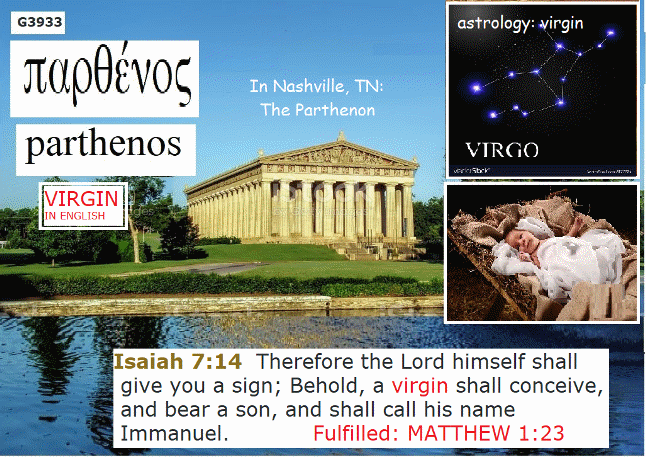Genesis 3:15, “And I will put enmity between thee [the deceiver] and the woman, and between thy seed and her seed; it shall bruise thy head, and thou shalt bruise his heel.”


Man and woman were created in a perfect state and placed in Earth’s Paradise, the garden of Eden, where the tree of eternal life was. But their sin caused them to be driven from this blissful life and especially from the tree of (eternal) life (and consequently also us their children).
THE PROMISE. The Jewish Scriptures (OT) assures us that while mankind was betrayed through the deception of woman, i.e., Mother Eve, the hope of humanity's salvation would be realized likewise through woman represented in context by our mother Eve (i.e., "her seed", Genesis 3:15; compare 1 Timothy 2:15). If we grant that there is not only a reproductive seed of man but one of woman (“females have around 6 million eggs from birth” ii), then we have the “hope” promise of a virgin birth from the dawn of creation. iii
What God promised to Adam and Eve (Genesis 3:15), Abraham (Genesis 12:7; 13:15; 24:7), Judah (Genesis 49:10), and David (2 Samuel 7:12–15) agrees with what He promised to Isaiah.
“Therefore the Lord Himself will give you a sign: Behold, a virgin will be with child and bear a son, and she will call His name Immanuel” (Isaiah 7:14).
There is a question about Isaiah actually using the Hebrew word virgin in the predicted "sign." The skeptics and unbelievers enjoy asserting that Matthew got it wrong. The current Masoretic text has Isaiah using the Hebrew word "maiden" almah only one time in his entire corpus (7:14); while the prophet uses the virgin word (betulah) five times elsewhere throughout the book of Isaiah (23:4; 23:12; 37:22; 47:1; 62:5). iv If this was true then not only is there a problem with it being unique to be "a sign" but Matthew made a false application and lied about the prediction. Regardless, “the Septuagint version of Isaiah, which was translated by seventy Jewish scholars in the 2nd century BCE, and the Gospel of Matthew both use the Greek word parthenos, which unambiguously translates as virgin.” v Where did these translations get the word if it was not in an original? It should be noted at this time that we do not have the original Hebrew available. The Masoretic text used by KJV is only from the tenth century AD while Jerome's Latin translation is from Hebrew texts from the fifth century. Jerome learned Hebrew (knowing Latin well) but claims he consulted with his contemporary Jewish rabbis.viii
SUPPOSITION.
The recovered Dead Sea Scrolls' ancient Isaiah papyri (which predates Matthew by a couple hundred years) has in 7:14 the Hebrew almah that matches the Masoretic text.ix
This supports the supposition that almah is a Hebrew synonym for betulah (virgin) and was used interchangeably in old Hebrew. To demonstrate, the virgin Rebekah in Genesis 24 is described using all three Hebrew terms.
Genesis 24:16a, "And the girl [na'arah] was very beautiful, a virgin [betulah],
and no man had relations with her." But in verse 43a, "almah" is used for her:
"...the maiden [almah] who comes out to draw (water)."
But in these two verses, the Greek Septuagint reads: "'the parthenos was very beautiful ... she was a parthenos, a man had not known her ..."; " ... the parthenos who comes out to draw water."
In Hebrew there are semantic differences between the three words used for Rebekah:
(1) girl (na'arah) -- relates to her gender;
(2) virgin (betulah) -- relates to sexual experience;
and (3) maiden (almah) -- relates to marriage status.
These descriptive nouns for Rebekah are conceptually identical: a na'arah is a betulah is an almah -- and is (in Greek) a parthenos. At any rate the Holy Spirit, through His
inspired apostle Matthew (who as a Jew would have known Hebrew), defines the
original prophetic meaning given as intended and understood by all in the first century: virgin
(Matthew 1:23; Timothy 3:16).
HISTORICAL CASE. The incarnation of God’s Son exclusively through a woman (Genesis 3) is a sign to the world that God hasn’t forsaken His people's salvation. In the historical background, the prophet Isaiah is addressing king Ahaz of Judah who was under attack by the northern Kingdom of Israel and its ally Aram-Damascus (Syria). Their intent was to have King Ahaz, David's descendant in Judah, to join them in an alliance to fight against the powerful Neo-Assyrian Empire. Although Ahaz was apparently scared, he refused to acknowledge any help from Jehovah. Nonetheless, Assyria came to king Ahaz’s assistance and destroyed the (northern) Kingdom of Israel and Syria.
When disobedient King Ahaz refused Isaiah's offer to ask the Lord for a sign of salvation for him, Isaiah goes ahead and gives the significant predictive sign “to the house of Judah” of the birth to a virgin. The current Jewish Masoretic text does not exactly say "virgin" but uses a similar word "young woman"vi in the Hebrew. Was this changed by post Jesus rabbis as they did the genealogies (e.g., Genesis 11)? One would wonder if Ahaz or any later Jew would see such as a sign since a young woman giving birth is natural, not unusual. Matthew either by inspiration translates what was the original Hebrew or quotes from the Jewish-Greek translation LXX. At any rate the birth of Jesus of the virgin's seed fulfils the sign for mankind (Genesis 3) and for the house of David. And Joseph representing the first century Jewish community understood such to be the prophecy of a real virgin and therefore as a result did not cast away Mary as an adulteress.
Thanks be to our merciful God the promise given to the serpent has been fulfilled in Mary and Jesus. Therefore, Jesus dying on the cross and rising from the dead bruised the head of the evil deceiver and his power. This has made it possible for humanity to be saved. To mankind now, the following is possible. “ … if thou shalt confess with thy mouth the Lord Jesus, and shalt believe in thine heart that God hath raised him from the dead, thou shalt be saved” (Romans 10:9). The apostle Paul says this after he admonishes in an earlier chapter: (Romans 6:3-4) the following:
“Know ye not, that so many of us as were baptized into Jesus Christ were baptized into his death? Therefore we are buried with him by baptism into death: that like as Christ was raised up from the dead by the glory of the Father, even so we also should walk in newness of life.”
NOTES:
VINE'S Vine's Expository Dictionary of New Testament Words
παρθένος parthénos, par-then'-os; of unknown origin; a maiden; by implication, an unmarried daughter:—virgin.
(a) of "the Virgin Mary," Matthew 1:23; Luke1:27;
(b) of the ten "virgins" in the parable, Matthew 25:1, 7, 11;
(c) of the "daughters" of Philip the evangelist, Acts 21:9;
(d) those concerning whom the Apostle Paul gives instructions regarding marriage, 1 Corinthians 7:25, 28, 34; in 1 Corinthians 7:36-38, the subject passes to that of "virgin daughters" (RV), which almost certainly formed one of the subjects upon which the church at Corinth sent for instructions from the Apostle; one difficulty was relative to the discredit which might be brought upon a father (or guardian), if he allowed his daughter or ward to grow old unmarried. The interpretation that this passage refers to a man and woman already in some kind of relation by way of a spiritual marriage and living together in a vow of virginity and celibacy, is untenable if only in view of the phraseology of the passage;
(e) figuratively, of "a local church" in its relation to Christ, 2 Corinthians 11:2;
(f) metaphorically of "chaste persons," Revelation 14:4.
ONLY JESUS' BIRTH FULFILS THE ISAIAH'S SIGN AND THE PREDICTION IN THE GARDEN
editors-- Janie Ward and Mary West
i “This [REPRODUCTIVE] seed is a very minute cell that is present in all men and women.” https://www.thisdaylive.com/index.php/2017/10/28/the-seed-of-a-man-sperm/
ii https://www.healthline.com/health/womens-health/how-many-eggs-does-a-woman-have#what-were-born-with
iii https://www.thisdaylive.com/index.php/2017/11/04/the-female-seed-egg/
iv https://outreachjudaism.org/alma-virgin/
v https://en.wikipedia.org/wiki/Matthew_1:23. The current Masoretic text of 10th century Isaiah has “young woman” which dates back only to the second or third century AD post Matthew and the rise of Christianity. However, without the original Hebrew text of Isaiah 7:14 we do know the Hebrew translators of Greek LXX (2nd or 3rd BC) has “virgin” and the Syriac translation of the original Hebrew's Isaiah 7:14 reads “chaste girl” or “virgin.” These two witnesses plus Matthew's Holy Spirit translation validate the prediction of the virgin birth (Deuteronomy 19:15). Did the second century's Jewish rabbis change their Hebrew text along with their changes of the genealogies of Genesis 11, etc? -gw
vi {(עַלְמָה)H5959} Pulpit Commentary. “The rendering "virgin" has the support of the best modern Hebraists, as Lowth, Gesenins, Ewald, Delitzsch, Kay. It is observed with reason that unless ’almah is translated "virgin," there is no announcement made worthy of the grand prelude: "
vii https://www.blueletterbible.org/lexicon/g3933/kjv/tr/0-1/
viii https://www.christianitytoday.com/history/issues/issue-28/405-jerome-completes-vulgate.html Such rabbis would surely have been prejudiced. In issues of Hebrew texts Jerome sided with the rabbis. "The most important influence which the Jews had upon Jerome was in impressing him with the authenticity of the Hebrew text of the Bible--the veritas hebraica or 'Hebrew truth'." https://www.notredamedesion.org/en/dialogue_docs9b66.html?a=3b&id=1120
www.BibleStudyLessons.net

|